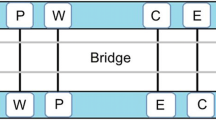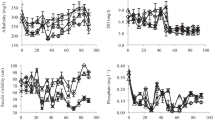Abstract
Biofloc technology is considered as a method that degrades organic waste by microorganisms and produces microbial flocs. A 30-day experiment was performed to investigate the effects of partial replacement of daily feeding intake with biofloc on the growth performances, digestive enzymes activity and liver histology of the common carp Cyprinus carpio L. fingerlings. Two hundred and eight healthy fingerlings (58.6 ± 0.2 g) were randomly distributed in 12 tanks (30 L) at a density of 25.4 kg m−3 and fed experimental treatments (100 % daily feeding rate as a control, biofloc + 75 % daily feeding rate, biofloc + 50 % daily feeding rate, biofloc + 25 % daily feeding rate). At the end of experiment, the results indicated that the highest weight gain was observed in the fish fed BFT 75 % and control which differed significantly from those fed BFT 25 % (P < 0.05). Diet BFT 75 % improved total protease and pepsin activity compared with BFT 25 and 50 % (P > 0.05). No significant difference was observed in case of lipase, amylase and alkaline phosphatase activity between the treatments. In the liver, histological alterations were found in the treatments, and feeding the fish with BFT 75 % significantly improved hepatocellular quantification and qualification than the other groups. The results obtained in this experiment suggest that the biofloc improves growth performances, digestive enzyme activity and liver condition of the common carp fingerlings when 25 % of daily feeding rate (BFT 75 %) was replaced with one carbohydrate such as molasses in zero-water exchange system.


Similar content being viewed by others
References
Asaduzzaman M, Wahab MA, Verdegem MCJ, Huque S, Salam MA, Azim ME (2008) C/N ratio control and substrate addition for periphyton development jointly enhance freshwater prawn Macrobrachium rosenbergii. Aquaculture 280:117–123
Avnimelech Y (1999) C/N ratio as a control element in aquaculture systems. Aquaculture 176:227–235
Avnimelech Y (2006) Bio-filters: the need for a new comprehensive approach. Aquac Eng 34:172–178
Avnimelech Y (2007) Feeding with microbial flocs by tilapia in minimal discharge bioflocs technology ponds. Aquaculture 264:140–147
Avnimelech Y (2009) Biofloc technology—a practical guide book. The World Aquaculture Society, Baton Rouge, p 181
Avnimelech Y, Kochva M, Diab S (1994) Development of controlled intensive aquaculture systems with a limited water exchange and adjusted carbon to nitrogen ratio. Isr J Aquacult-Bamid 46:119–131
Avnimelech Y, Verdegem MCJ, Kurup M, Keshavanath P (2008) Sustainable land- based aquaculture: rational utilization of water, land and feed resources. Mediterr Aquac J 1:45–55
Azim ME, Little DC (2008) The biofloc technology (BFT) in indoor tanks: water quality, biofloc composition, and growth and welfare of Nile tilapia (Oreochromis niloticus). Aquaculture 283:29–35
Bauer W, Prentice-Hernandez C, Tesser MB, Wasielesky W Jr, Poersch LHS (2012) Substitution of fishmeal with microbial floc meal and soy protein concentrate in diets for the pacific white shrimp Litopenaeus vannamei. Aquaculture 15:112–116
Becerra-Dórame MJ, Martínez-Porchas M, MartínezCórdova LR, Rivas-Vega M, López-Elías JA, Porchas-Cornejo MA (2012) Production response and digestive enzymatic activity of the Pacific white shrimp Litopenaeus vannamei (Boone 1931) intensively pregrown in microbial heterotrophic and autotrophic-based systems. Sci World J. doi:10.1100/2012/723654
Bessey OA, Lowry OH, Brock MJ (1946) Rapid coloric method for determination of alkaline phosphatase in five cubic millimeters of serum. J Biolog Chem 164:321–329
Bradford M (1976) A rapid and sensitive method for the quantitation of microgram quantities of protein utilizing the principle of protein-dye binding. Anal Biochem 72:248–254
Burford MA, Sellars MJ, Arnold SJ, Keys SJ, Crocos PJ, Preston NP (2004) Contribution of the natural biota associated with substrates to the nutritional requirements of the post-larval shrimp, Penaeus esculentus (Haswell) in high density rearing systems. Aquac Res 35:508–515
Caballero MJ, Izquierdo MS, Kjørsvik E, Montero D, Socorro J, Fernández AJ, Rosenlund G (2003) Morphological aspects of intestinal cells from gilthead seabream (Sparus aurata) fed diets containing different lipid sources. Aquaculture 225:325–340
Crab R, Chielens B, Wille M, Bossier P, Verstraete W (2010) The effect of different carbon sources on the nutritional value of bioflocs, a feed for Macrobrachium rosenbergii postlarvae. Aquac Res 41:559–567
De Schryver P, Crab R, Defoirdt T, Boon N, Verstraete W (2008) The basics of biofocs technology: the added value for aquaculture. Aquaculture 277:125–137
Ekasari J, Zairin M Jr, Putri DU, Sari NP, Surawidjaja EH, Bossier P (2015) Biofloc based reproductive performance of Nile tilapia Oreochromis niloticus L. broodstock. Aquac Res 46:509–512
Fontagne S, Geurden Y, Escaffre AM, Bergot P (1998) Histological changes induced by dietary phospholipids in intestine and liver of common carp Cyprinus carpio L. larvae. Aquaculture 161:213–223
Gutierrez-Wing MT, Malone RF (2006) Biological filters in aquaculture: trends and research directions for freshwater and marine applications. Aquac Eng 34:163–171
Hardy RW (2010) Utilization of plant proteins in fish diets: effects of global demand and supplies of fishmeal. Aquac Res 41:770–776
Harris JM (1993) The presence, nature, and role of gut micro flora in aquatic invertebrates: a synthesis. Microb Ecol 25:195–213
Hassaana MS, Soltan MA, Abdel-Moez AM (2015) Nutritive value of soybean meal after solid state fermentation with Saccharomyces cerevisiae for Nile tilapia, Oreochromis niloticus. Anim Feed Sci Technol 201:89–98
IFO (Iranian fisheries organization) (2014) Fishery annual report. IFO bulletin
Iijima N, Tanaka S, Ota Y (1998) Purification and characterization of bile salt-activated lipase from the hepatopancreas of red sea bream (Pagrus major). Fish Physiol Biochem 18:59–69
Langlois A, Corring T, Fevrier C (1987) Effects of wheat bran on exocrine pancreas secretion in the pig. Reprod Nutr Dev 27:929–939
Lieber CS (2003) Relationships between nutrition, alcohol use, and liver disease. Alcohol Res Health 27:220–231
Luo G, Wang C, Liu W, Sun D, Li L, Tan H (2014) Growth, digestive activity, welfare, and partial cost-effectiveness of genetically improved farmed tilapia (Oreochromis niloticus) cultured in a recirculating aquaculture system and an indoor biofloc system. Aquaculture 422–423:1–7
Mahanand SS, Moulick S, Rao S (2013) Water quality and growth of rohu, Labeo rohita in a biofloc system. J Appl Aquac 25:121–131
Martínez-Llorens S, Baeza-Ariño R, Nogales-Mérida S, Jover-Cerdá M, Tomás-Vidal A (2012) Carob seed germ meal as a partial substitute in gilthead sea bream (Sparus aurata) diets: amino acid retention, digestibility, gut and liver histology. Aquaculture 338–341:124–133
Mc Intosh RP (2000) Changing paradigms in shrimp farming IV, low protein feeds and feeding strategies. Glob Aquac Advocate 3:44–50
Megahed ME (2010) The effect of microbial biofloc on water quality, survival and growth of the green tiger shrimp (Penaeus semisulcatus) fed with different crude protein levels. J Arab Aquac Soc 5:119–141
Mosconi-Bac N (1987) Hepatic disturbances induced by an artificial feed in the sea bass Dicentrarchus labrax during the first year of life. Aquaculture 67:93–99
Moss SM, Divakaran S, Kim BG (2001) Stimulating effects of pond water on digestive enzyme activity in the Pacific white shrimp, Litopenaeus vannamei (Boone). Aquac Res 32:125–131
Ødegård JJ, Olesen I, Dixon P, Jeney Z, Nielsen HM, Way K, Joiner C, Jeney G, Ardo L, Ronyai A, Gjerde B (2010) Genetic analysis of common carp (Cyprinus carpio) strains. II: resistance to koi herpesvirus and Aeromonas hydrophila and their relationship with pond survival. Aquaculture 304:7–13
Ostaszewska T, Dabrowski K, Czumińska K, Olech W, Olejniczak M (2005) Rearing of pike-perch larvae using formulated diets–first success with starter feeds. Aquac Res 36:1167–1176
Rašković BS, Stanković MB, Marković ZZ, Poleksić VD (2011) Histological methods in the assessment of different feed effects on liver and intestine of fish. J Agric Sci 56:87–100
Samocha TM, Lawrence AL, Collins CA, Castille FL, Bray WA, Davies CJ, Lee PG, Wood GF (2004) Production of the Pacific white shrimp, Litopenaeus vannamei, in high-density greenhouse-enclosed raceways using low salinity groundwater. J Appl Aquac 15:1–19
Segner H, Witt U (1990) Weaning experiments with turbot Scophthalmus maximus: electron microscopic study of liver. Mar Biol 105:353–361
Tacon AGJ (1992) Nutritional fish pathology: morphological signs of nutrient deficiency and toxicity in farmed fish. Food and Agriculture Organization of the United Nations, Rome
Torrecillas SA, Makol MJ, Caballero D, Montero L, Robaina F, Real J, Sweetman L, Tort M, Izquierdo S (2007) Immune stimulation and improved infection resistance in European sea bass (Dicentrarchus labrax) fed mannan oligosaccharides. Fish Shellfish Immunol 23:969–981
Walter H (1984) Proteinases: methods with hemoglobin, casein and azocoll as substrates. In: Bergmeyer HU (ed) Methods of enzymatic analysis, vol V. Verlag Chemie, Weinheim, pp 270–277
Wang G, Yu E, Xie J, Yu D, Li Z, Luo W, Qiu L, Zheng Z (2015) Effect of C/N ratio on water quality in zero-water exchange tanks and the biofloc supplementation in feed on the growth performance of crucian carp, Carassius auratus. Aquaculture 443:98–104
Wasielesky W, Atwood H, Stokes A, Browdy CL (2006) Effect of natural production in a zero exchange suspended microbial floc based superintensive culture system for white shrimp Litopenaeus vannamei. Aquaculture 258:396–403
Xu WJ, Pan LQ (2012) Effects of bioflocs on growth performance, digestive enzyme activity and body composition of juvenile Litopenaeus vannamei in zero-water exchange tanks manipulating C/N ratio in feed. Aquaculture 356–357:147–152
Xu WJ, Pan LQ, Zhao DH, Huang J (2012a) Preliminary investigation into the contribution of bioflocs on protein nutrition of Litopenaeus vannamei fed with different dietary protein levels in zero-water exchange culture tanks. Aquaculture 350–353:147–153
Xu WJ, Pan LQ, Sun XH, Huang J (2012b) Effects of bioflocs on water quality, and survival, growth and digestive enzyme activities of Litopenaeus vannamei (Boone) in zero-water exchange culture tanks. Aquac Res 2012:1–10
Xu WJ, Pan LQ, Sun XH, Huan J (2013) Effects of bioflocs on water quality, and survival, growth and digestive enzyme activities of Litopenaeus vannamei (Boone) in zero-water exchange culture tanks. Aquac Res 44:1093–1102
Yu GH, He PJ, Shao LM, Lee DJ (2007) Enzyme activities in activated sludge flocs. Appl Microbiol Biotechnol 77:605–612
Yu GH, He PJ, Shao LM, Zhu YS (2009) Enzyme extraction by ultrasound from sludge flocs. J Environ Sci 21:204–210
Zambonino JL, Cahu CL (1994) Influence of diet on pepsin and some pancreatic enzymes in sea bass (Dicentrarchus labrax) larvae. Comp Biochem Physiol 109:209–212
Zhao P, Huang J, Wang XH, Song XL, Yang CH, Zhang XG, Wang GC (2012) The application of bioflocs technology in high-intensive, zero exchange farming systems of Marsupenaeus japonicus. Aquaculture 354–355:97–106
Zhao ZG, Xu QY, Luo L, Yin JS, Wang CA (2013) Effect of adding carbon source on growth of fish and water quality in Songpu mirror carp (Cyprinus specularis Songpu) pond. J Northeast Agric Univ 44:105–112 (in Chinese with English abstract)
Zhu XZ, Liu YJ, Tian LX, Mai KS, Zheng SX, Pan QJ, Cai MC, Zheng CQ, Zhang QH, Hu Y (2010) Effects of dietary protein and lipid levels on growth and energy productive value of pacific white shrimp, Litopenaeus vannamei, at different salinities. Aquac Nutr 16:392–399
Author information
Authors and Affiliations
Corresponding author
Rights and permissions
About this article
Cite this article
Najdegerami, E.H., Bakhshi, F. & Lakani, F.B. Effects of biofloc on growth performance, digestive enzyme activities and liver histology of common carp (Cyprinus carpio L.) fingerlings in zero-water exchange system. Fish Physiol Biochem 42, 457–465 (2016). https://doi.org/10.1007/s10695-015-0151-9
Received:
Accepted:
Published:
Issue Date:
DOI: https://doi.org/10.1007/s10695-015-0151-9




